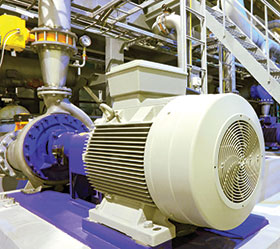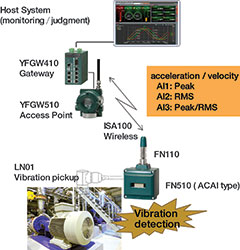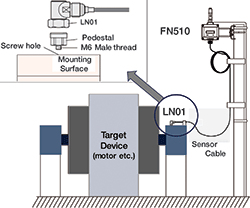

Wireless networks make continuous monitoring of rotating equipment more practical and cost effective. When we think of process manufacturing facilities, we tend to picture pipes, tanks, valves and instrumentation. This picture is correct, but we often tend to overlook how much rotating equipment there is and how critical it is to overall operation. If a pump, compressor or other device fails, it can have a serious effect on production. The fact that many pumps are configured in dual redundant installations gives an indication of their importance.
One of the great enemies of rotating equipment is vibration, which has a variety of causes. Consider a typical ANSI pump driven by a motor with a flexible coupling. If the two shafts are not truly on a common centreline, the coupling will compensate for the misalignment, but it will likely introduce vibration into the installation. Vibration creates detrimental forces within the bearings, causing premature wear, which further increases the overall vibration. Over a period of time, the problem will compound until one or more of the bearings fails. The pump’s mechanical seals may also suffer damage and begin to leak. Before long, the installation must be shut down and overhauled.
In addition to the vibration inherent with any rotating equipment, at least at some level, vibration can also be transmitted via piping and support structures from other equipment within the process unit. Consequently, vibration cannot be eliminated entirely, but it can be measured. Sensors are available to characterise and quantify the amount of vibration, and to capture characteristic patterns, often referred to as signatures. These vibration monitoring systems typically use a piezoelectric sensor to create and transmit a signal proportional to measured vibration.
Vibration sensors have been available for many years, but older systems were costly to install, limiting their deployment to the most expensive and critical rotating equipment. For other installations, technicians carried portable units on routine inspections of the plant,
manually checking bearings, seals and other critical points. Sophisticated portable systems could capture historical information and compare specific installations over time, but the readings were still performed at potentially lengthy time intervals, and depended on operators carrying out the inspections. Performing such rounds has always been expensive and time consuming, and when plants have minimal manpower, they can be delayed or skipped when more pressing tasks emerge.
Advantages of continuous monitoring
Short of a catastrophic failure of some component, vibration problems do not usually advance drastically in a brief period of time. This fact is usually cited to support the idea of periodic inspections. Unfortunately, vibration problems may increase slowly until they reach a critical point, and then the climb becomes much steeper toward failure, which can easily happen before the next scheduled manual inspection.
Continuous monitoring can detect those situations when the vibration curve begins to climb toward a failure point, informing maintenance technicians while there is still time to respond before a failure and outage. Software can spot those kinds of movements and sound alarms appropriate to the urgency of the situation and criticality of the equipment.

Less expensive vibration sensors have made permanent installations more practical for more pieces of equipment, but the cost of wiring a sensor has not gone down, and in many situations has become even more expensive. One of the biggest technological advances of the last decade has been the emergence of effective and practical wireless instrumentation protocols, including ISA100 Wireless. Yokogawa has expanded its range of wireless field instruments used to measure basic process variables such as pressure, temperature, level and flow, and now wireless vibration sensors are part of their product offerings.
A new wireless vibration sensor
Yokogawa has created a sensor and wireless transmitter system designed specifically for continuous monitoring of the rotating equipment commonly used in process manufacturing facilities (Figure 1). The system is designed for easy installation on a wide variety of equipment.
The piezoelectric acceleration sensor is compact and easy to install near the device’s bearings (Figure 2). A cable connects it to a wireless communication module, which can be mounted wherever it is convenient, and where it can be clear of obstructions able to interfere with its signal propagation.

The complete system is self-powered using a battery in the communication module. With a one-minute data update rate, one set of batteries can run for up to 10 years. The data is sent via the wireless network to the system gateway. If other ISA100 Wireless field devices are already in use in the facility, the vibration monitors can become part of the same network, communicating with the gateway just like any other communication module or sensor. Data from the units installed throughout the plant can be directed to a control or monitoring system to inform operators and maintenance personnel as conditions change with the equipment being monitored.
Vibration analysis methods
The piezoelectric vibration sensor is an accelerometer capable of measuring velocity and acceleration. The nature of the vibration and the type of equipment helps determine which analytical method is best when the primary objective is determining equipment condition. The rule-of-thumb suggests that where frequencies are low, velocity is the preferred measure, but when frequency increases, it is better to measure acceleration.
Plant personnel can make the determination of how frequently readings should be taken, and what analytical techniques should be used for each installation. Ranges of what is considered tolerable vibration versus dangerous have been published by various sources, but the ultimate guidelines for a given piece of equipment in each plant may need to be established in cooperation with the equipment OEM.
While the sensor can send a new reading as often as every 10 seconds, the need for such rapid refreshment is rare, and it comes at the cost of battery life. Switching to an update rate of once per minute can extend battery life significantly, while still providing more than enough data for most applications.
If more sophisticated analysis is required, software packages are available from third-party vendors to look for patterns and identify sources of abnormal vibration. This type of work is done in the host system rather than the individual devices, and often combines signals from multiple sensors deployed around the equipment to pinpoint sources of trouble.
Launching a vibration monitoring program
Implementations of vibration monitoring programs are usually incremental, working down the list of installations beginning with the most critical. In this context, ‘critical’ takes different forms, the foremost of which typically involves the likelihood of production being interrupted due to an outage. If the process cannot run without a given pump and there is no spare ready to switch over, it is critical, regardless of its cost. Most plants are aware of those installations, particularly if they have a history of problems.
Secondary and tertiary levels can get more complex. Some organisations select based on equipment cost. At the same time, other considerations, such as difficulty of repair or availability of spare parts, enter into the picture, but they are more difficult to quantify. Ultimately it is important to include a variety of measures from different viewpoints when making such decisions.
It is also important to select an appropriate asset management platform to gather and process the data from the sensors around the plant. Once more information is available, questions emerge as to how it is used and where it goes. Who should receive alarms? Maintenance? Control room operators? If a highly critical installation is beginning to show signs of a problem, the control room may need to be informed if operators need to take action before the situation is turned over to maintenance for repair. An effective asset management system can handle these sorts of situations.
The combination of effective technologies
Process manufacturers can benefit from this combination of economical sensors combined with wireless networks. Working together, they provide critical information to operators and other plant personnel to warn of potential problems before the plant suffers damage or lost production. In some situations, the avoidance of a single outage saves enough money to pay for monitoring many pieces of equipment. This approach is highly flexible and scalable, allowing a facility to begin in one area, and then expand as needs and circumstances permit.
For more information contact Christie Cronje, Yokogawa South Africa, +27 (0)11 831 6300, christie.cronje@za.yokogawa.com, www.yokogawa.com/za
| Tel: | +27 11 831 6300 |
| Fax: | +27 11 86 411 8144 |
| Email: | yma.info-za@yokogawa.com |
| www: | www.yokogawa.com/za |
| Articles: | More information and articles about Yokogawa South Africa |
© Technews Publishing (Pty) Ltd | All Rights Reserved